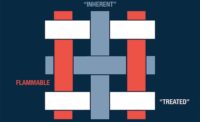There are many reasons frequently cited by safety directors as to why they answer the fabric question first.
1 Protection
Protective performance ratings (ATPV, or Arc Rating; NFPA 2112, or flash fire rating; etc) are based entirely on the FR fabric. We don’t get a rating on a blue shirt or a red coverall; the protective designations are fabric brand and weight specific. All single-layer garments made of that particular brand and weight of fabric will then carry that rating, regardless of garment type, manufacturer, color and so on.
2 FR durability
The protective performance tests are excellent, and the ratings are highly reliable and relevant to the hazards they address, but they do not prove long-term durability of flame resistance. The arc rating test (ASTM F-1959) uses fabric samples washed three times and dried once. As a result of this, and other important issues around garment construction, ASTM F-1506 is often the next thing specified, because it requires FR durability through 25 launderings. This only represents about six months to one year of use, but most FR garments are expected to be in service two to five years, leaving a significant gap between existing arc flash standards and actual field use.
Many people look to NFPA 2112 to fill this gap, even if they do not have a flash fire hazard, because one of the 2112 requirements measures flame resistance (per Vertical Flame, ASTM 6413) after 100 industrial launderings. While this may seem sufficient
at first glance, there are two issues to consider. First, the wash method in the standard uses perfect water chemistry, temperatures, detergents, load levels, operator skills, etc. Real world laundering is often much more aggressive, and potentially detrimental to some FR technologies. Second, fabrics are submitted for testing by the manufacturer, who can then carefully walk a specific sample through a process to achieve a desired test result. However, the tested sample may bear very little resemblance to what is being produced in full commercial scale months or years later.
The standards are minimum compliance bars, broadly written and intended to be inclusive, not exclusive. This is why so many safety managers insist on established, market-proven brands. Market proof is not based on de minimus standards, or marketing spin, or sales claims. Market proof is when the industry votes, over time, with its wallet; in other words, a product is specified, serves its purpose well, and when replacement is necessary years later, the same product is selected again and again.
Valued characteristics are not limited to protection; several other more basic garment traits are very important as well.
3 Shrinkage
A bargain fabric is no bargain at all if it has to be removed from service prematurely because it no longer fits due to excessive laundry shrinkage. It can also become a safety hazard if it is not worn, or is improperly worn because it is too small. Almost everything shrinks somewhat in laundering, but some fabrics shrink both more rapidly and more excessively; low price is often an excellent indication of products with significant shrinkage problems. This is because quality preshrinking is both difficult and expensive. It is difficult because many FR technologies can achieve either good FR durability to laundering or reasonable shrinkage control, but not both. There are very few processes that are able to achieve FR durability for the life of the garment, and excellent shrinkage control.
Control is achieved by compaction of the fabric at the end of the process. To understand why this is expensive, picture a machine in which, for every 100 yards of fabric that enter, only about 90 yards exit, reducing salable inventory by 10 percent. This technology allows the manufacturer to take the hit on the shrinkage cost, so the end user does not.
4 Cost
While FR fabrics vary widely in price, they represent, on average, over half the cost of a finished FR garment. Since the fabric is the largest cost component, it makes sense to carefully consider the options and performance characteristics.
5 Comfort
The largest components of comfort, other than fit, are also dictated by the fabric brand. Qualities like softness (new and over time), breathability, moisture management, etc. have a major impact on the comfort of the wearer. As with shrinkage, cost is again often an excellent barometer of comfort, because for many technologies, FR durability and softness are at odds. Only a very few brands manage both, and these tend to be more expensive because the necessary processes and equipment are expensive.
6 Appearance
Garment appearance over time is not important to everyone, but in many cases, FR garments are also considered to be uniforms, and thus a part of a company’s public image. No one wants to remove garments from service early because a red shirt turned pink or blue coveralls faded to gray. Less expensive dyes result in less expensive garments, but at the cost of poor color retention through laundering. In addition, stiff fabrics can lead to streaks or “chalking” in darker colors because of abrasion at garment stress points. This negatively impacts the appearance and can substantially reduce the garment wear life.
These differences can be quite significant across fabric categories (i.e. aramids vs. FR cottons), but many people are surprised to learn there are also major differences within a fabric category (i.e. one FR cotton brand vs. another). Taken in sum, it’s easy to see why most safety professionals rate the FR fabric brand as the first and most critical decision in program implementation: the fabric is the key component of protective rating, durability of flame resistance, shrinkage, comfort, cost and long-term appearance.


